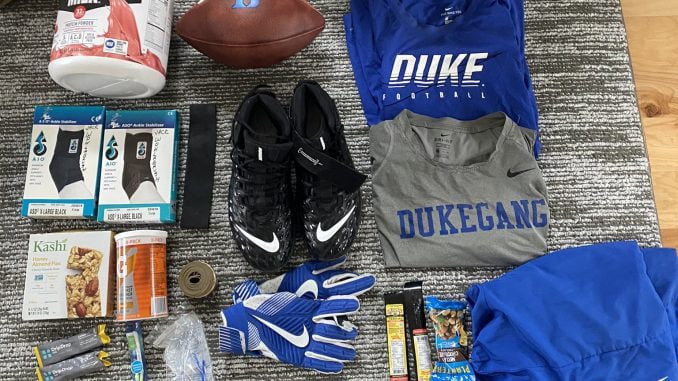
Champions are made in the weight room, or so goes the old football cliché, anyway. But what happens when weight rooms are locked and gyms are off-limits?
That was the problem facing most college football programs as the time usually slotted for offseason conditioning arrived, with the nation still mired in a shutdown due to the coronavirus pandemic.
At Duke, for instance, players usually spend much of the summer on campus, taking courses in both summer sessions and working out regularly under the watchful eye of strength and conditioning coach Noel Durfey.
Campus is closed, however. Classes are online and players are home. Not all homes are created equally, which makes Durfey’s job even tougher as he tries to make sure the Blue Devils get their weight work in despite what may be very different home environments.
“All you can do is the best you can do,” coach David Cutcliffe said. “We’re not with them. The difficult task is that they’re in different places and different environments. Different size of dwellings. Different abilities to go run, even on the street. That concerns me greatly.”
In the early days of the shutdown, the staff acted quickly to help the players.
“When this happened, we saw there was a chance of this being long-term,” Cutcliffe said. “When we were able to go over to the office, before the stay-home, we were able to put together care packages that we sent to every current player. We were able to send different kinds of strength bands, protein powders, really outstanding snacks, different things that they needed to focus on to be as best they can.”
Then Durfey contacted the players to see what they had available in or around their homes.
“After about a week or so, when everything really started closing down, we reached out to find out what guys have access to,” Durfey said on the Duke football podcast. “After we found out what guys have, we came up with four different workouts.”
Some players had basically the same type of setup they’d have in the Duke weight room, with a full set of weights. Some could do bench press and squats. Some just had dumbbells in the house. And some …
“A lot of guys didn’t have anything,” Durfey said.
When he says “a lot,” Durfey means “most.”
“I’d say it’s about 60/40,” he estimated. “With 60% don’t. 40% have access.”
So he and his staff had to design a workout using items commonly found around the house that would allow a Power Five college football player to get his lifting in.
First, Duke’s staff had to make sure that other items commonly found around the house weren’t going to negate the work Durfey was having the players put in.
“All of us in this quarantine mode, if you got snacks in your house, you’re crazy,” Cutcliffe said. “That’s what you go to first — all of us, including our players. … Beth Miller, our nutritionist, sends out information about reminders and proper nutrition and foods that make them feel full and foods that give them energy and foods that help recovery.”
Assuming the players are eating right, Durfey could set about finding things suitable for them to lift.
Does that mean Duke players around the country are busy deadlifting their refrigerator or pushing the family car up and down hills? Not quite. Durfey’s priority is to keep the players safe, even if it means they can’t get the strength gains from offseason work that players often see.
“They’ve got to come back in shape,” he said. “Worst-case scenario: They come back in July. There’s not enough time to get in shape. We can get stronger as we go along. That’s really the easier part.”
Instead, players are using something that every college student has available — their backpack. When filled with Duke textbooks, it can become very heavy. Duke’s workout plan involves doing pushups while wearing their backpacks and using them to add weight to leg lifts, delt raises (the dumbbell lift that looks like a bird flapping its wings) and lunges.
Jugs of water and large cans of food can help replace dumbbells for curls and other lifting exercises, and, often, a partner pulling on a towel wrapped around the player’s arm or leg can provide resistance. Durfey has the players using towel resistance for rowing exercises and curls.
To make sure the players understand exactly how they’re supposed to use these household props, and to avoid injury, Durfey and his staff upload videos demonstrating each new exercise and movement.
Eventually, the players will be able to return to campus, and then, it will be time to get ready for the season.
“When the kids do get back, man, it’s gonna be fast and furious,” Durfey said.
Despite that, he realizes that not everyone may have been able to stay in football shape with book bags and towels. As a result, he’s been busy ordering 110 heart-rate monitors to evaluate and monitor the players as they work out in the Duke weight room.
“We’ve got to be patient,” he said. “We’ve got to be calm. We’ve got to meet the kids where they are physically.”
He’s not too worried about the Blue Devils coming back out of shape, however.
“The teams with the most self-discipline will thrive in this type of environment,” he said. “We’ve got to be that team.”



